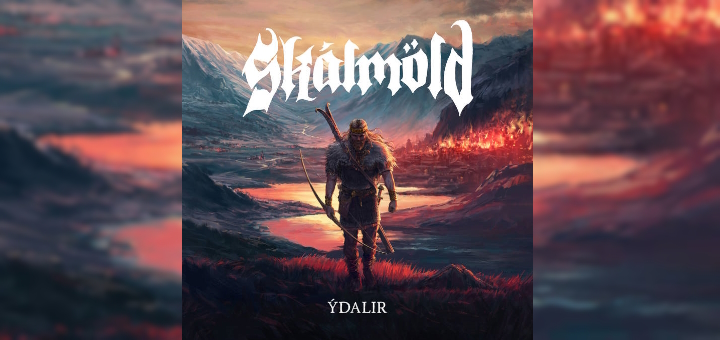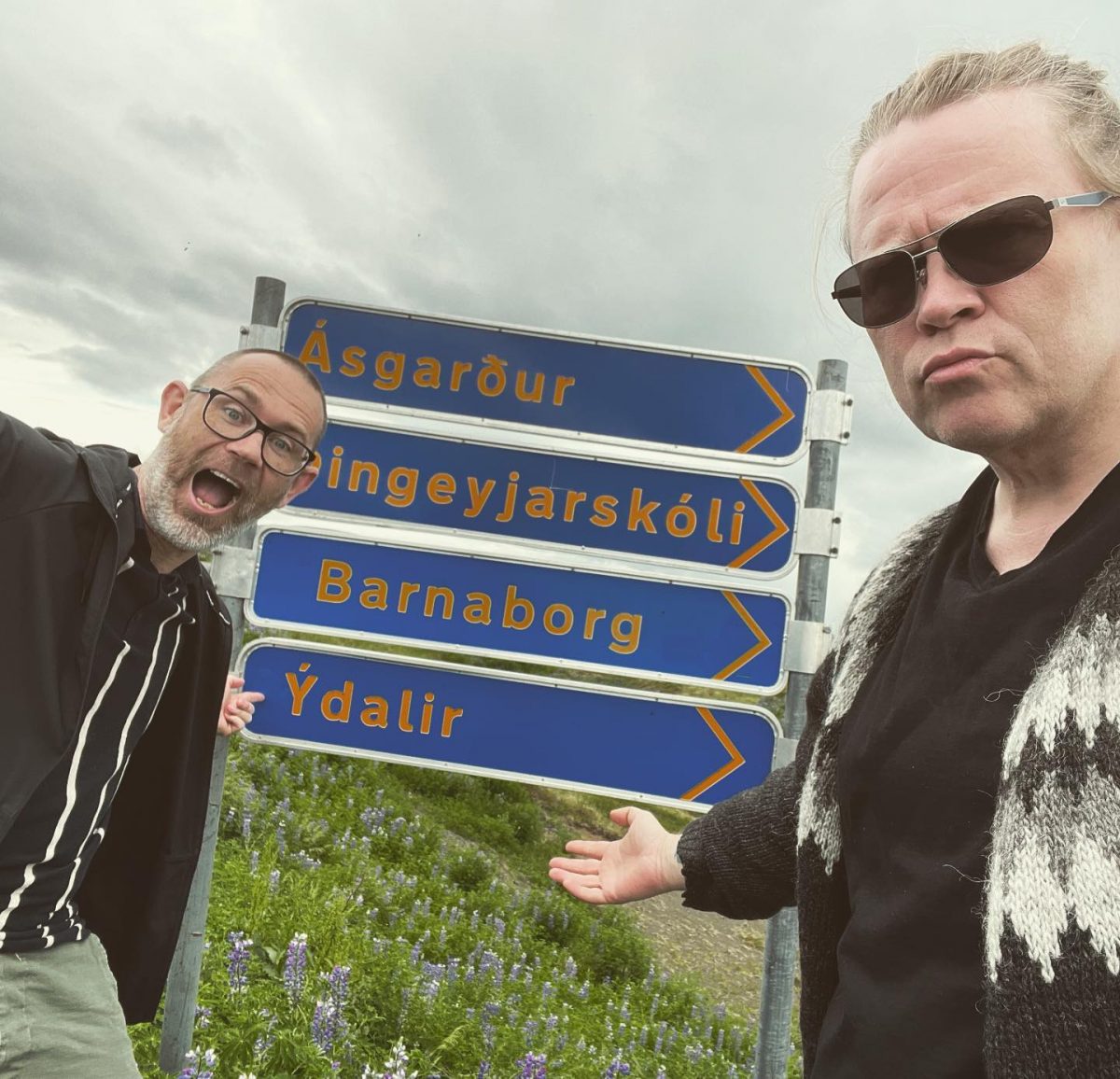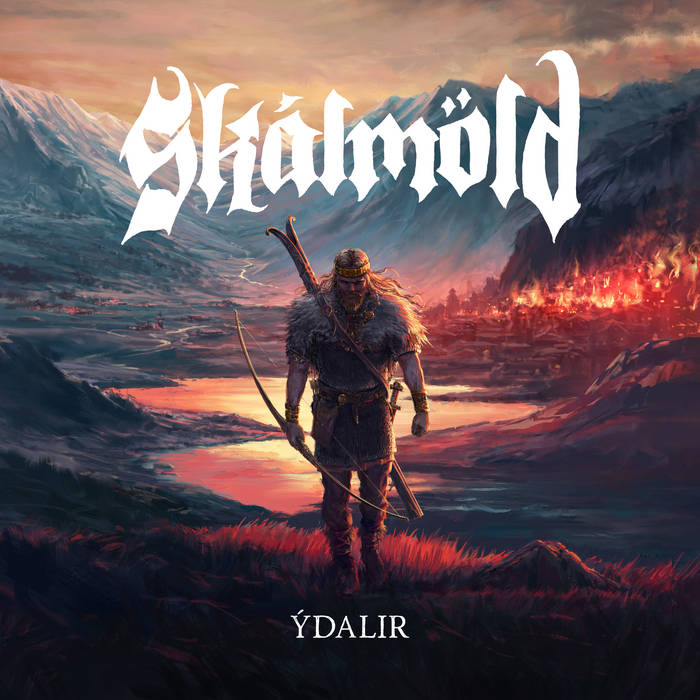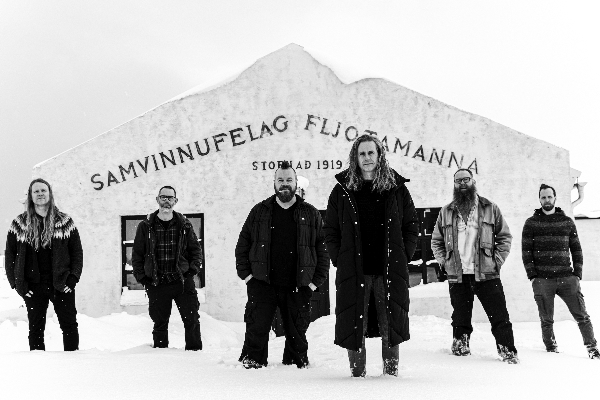„Ýdalir“ neues Album von SKÁLMÖLD

„Ýdalir“ – SKÁLMÖLD nach fünf Jahren mit neuem Album
(English version below)
Seit SKÁLMÖLD ihr fünftes Album „Sorgir“ veröffentlichten, sind fast fünf Jahre vergangen. Dies hat einmal damit zu tun, dass sie 2019 beschlossen, eine Pause zu machen, um nach den vielen Touren die Batterien aufzuladen und über neue Songs nachzudenken. Als sie wieder losstarten wollten, kam die Covid-Pandemie dazwischen.

Aber jetzt ist am 18. August 2023 endlich soweit: Album Nummer sechs erscheint. Es trägt den Titel „Ýdalir“. Ýdalir, die Eibentäler, in denen nach der nordischen Mythologie Ullur wohnt, dessen Geschichte das Album erzählt.
SKÁLMÖLD sind ihrer Linie, Songs auf der Basis der isländischen Sagen zu entwickeln, treugeblieben. Sie haben diese Grundidee weiterverfolgt, aber dabei neue Strukturen und Ideen entwickelt. Und für einige Überraschungen gesorgt.
Um es direkt zu sagen: es ist ein – im Wortsinne – sagenhaftes Album geworden. Musikalisch ist es härter als die Vorgänger. Aber dadurch wirken die Melodien noch mehr und transportieren neben der kraftvollen Energie eine verspielte Leichtigkeit, die ich an SKÁLMÖLD so mag. Es gibt Passagen zum Headbangen ebenso wie solche zum Mitsingen. Growls und Screaming wechselt mit klarem Gesang. Es gibt hymnische Teile, die organisch aus der Musik oder aus der erzählten Geschichte hervorgehen.
Die Magie des Geschichtenerzählens
Es sind eben wieder Geschichten, die erzählt werden. Geschichten zu Orten und Charakteren, die in der nordischen Mythologie eine Rolle spielen. Dabei übernehmen SKÁLMÖLD nicht die Texte aus der Edda, sondern haben neue Geschichten dazu geschrieben. Über Ullur z.B., der zentralen Figur des Albums, erfahren wir in der Grímnismál nicht viel. Aber SKÁLMÖLD scheinen sich einig gewesen zu sein, dass er es verdient, mehr über ihn zu erzählen.
Ýr und Ýdalir – der Anfang der Geschichte
Das instrumentale Intro „Ýr“ stimmt uns mit Orgel und akustischen Gitarren auf ruhige Momente, aufs Hinhören und Zuhören ein.
Aber sobald „Ýdalir“ beginnt, ist es vorbei mit Ruhe und Bedächtigkeit. Drängende Rhythmen bilden die Basis für Growls und Screams.
Ullur und die Seinen leben in Ýdalir in Frieden, bis Niðhöggur ihn zerstört. Die Tempowechsel, energische Riffs und das Anspielen von Melodien übermitteln die Bedrohung, die Unruhe, die Flucht. Und währenddessen weben die Nornen die Schicksalsfäden.
Die Flucht
„Veðurfölnir“ ist druckvoll und temporeich angelegt. Er hätte angesichts des dramatischen Geschehens durchaus härter, weniger melodiös sein können.
Nach Rhythmuswechsel und rockiger Passage geht es um die Hoffnung, dass sie auf der Flucht nicht den Mut verlieren. Hier passt der kraftvolle klare, harmonisch interessant gestaltete klare Gesang sehr gut. Der folgende gutturale Gesang spiegelt das Chaos der weiteren Flucht wider und erzählt von Veðurfölnir, dem Habicht und Yggrasils Adler.
Vergiss, bewahre und träume
In „Urður“, „Verðandi“ und „Skuld“ geht es um die Nornen, diese mythologischen Schwestern, die über das Schicksal der Menschen bestimmen. Um die Macht der Vergangenheit, den Genuss in der Gegenwart und darum, die Vergangenheit hinter sich zu lassen, aber mitzunehmen, was hilfreich war.

Snæbjörn, Baldur und Gunnar geben jeweils einer Norne die Stimme. Alle drei Lieder erzeugen Spannung durch Kontraste. Sei es durch den Wechsel von gutturalem und klaren Gesang oder fließende Leitmotive, die durch rasante Gitarrenparts unterbrochen werden.
So ist „Urður“ geprägt von einem dynamischen Basslauf, während bei „Verðandi“ die Oboe für den roten Faden sorgt. Bei „Skuld“ steht der dunkle, dramatische Bass im Gegensatz zum klaren Gesang.
Ich kann garnicht sagen, welcher der ‚Nornen-Songs‘ mir am besten gefällt. Aber „Verðandi“ wird sicherlich live ein toller Song, weil man wunderbar mitsingen kann.
Ratatoskur und Níðhöggur
„Ratatoskur“ ist das Eichhörnchen, das auf Yggrasil zwischen dem Adler und Níðhöggur, dem Drachen, der an einer der Wurzeln Yggdrasils lebt, hin und herläuft. Und so klingt der Song auch: mit einer eingängigen, flinken Melodie und doch schwer, wenn er von Ullurs Flucht erzählt.
„Níðhöggur“ erzählt über die Auseinandersetzung zwischen Ullur und dem Drachen. Hier gibt es durch den Chor, intensives Drumming, treibende Gitarrenparts und nicht zuletzt den Gesangspart von Þráinns Vater Baldvin Kristinn Baldvinsson epische Momente.
Ullur
Mit „Ullur“ nehmen Skálmöld sich 10 Minuten Zeit, um die Ereignisse zusammenzufassen. Die Lyrics in traditioneller Dichtform verfasst, untermalt durch Orgel- und Keyboard, mit wunderschönen Harmonien und tollen Riffs.
In der Mitte dann das Prasseln eines Feuers. Die Instrumentierung ist minimalistisch, so dass der wunderschöne und mitreißende Gesang – diesmal von Jón Geir, der dafür seinen Platz an den Drums verlassen hat – die Schicksalsjungfrauen beschwingt und ruhig zum Tanz einladen kann.
Fazit
„Ýdalir“ gefällt mir, weil das Prinzip, Geschichten zu erzählen, komplex und dennoch voller Leichtigkeit umgesetzt wird. Die Musik ist melodiös und dabei trotzdem hart und heavy ist. Und weil es voller Überraschungen steckt, was die stimmliche, harmonische aber auch rhythmische Gestaltung angeht. Wenn harte Growls und Screams sich mit hymnischen Chören und wieder schön von þráinn herausgespielten Gitarrensoli abwechseln, die gleichzeitig eingängig und komplex sind, entstehen tolle Momente.
An manchen Stellen hätte ich es mir rauer, schräger, vielleicht auch misstönender gewünscht, um die Dramatik der Geschichte, die sie erzählen, noch besser zu transportieren.
Über das Geschichtenerzählen hatte ich mich bereits mit Þráinn unterhalten.
Jede Geschichte ist ein Stück Magie. Wenn deine Großeltern dir eine Geschichte erzählen, egal ob wahr oder ein Mythos, verlierst du dich in der Erzählung. Warum fühlen sich die meisten Menschen entspannt, wenn sie an einem Lagerfeuer oder einer Feuerstelle sitzen? Weil es das ist, was die Menschheit am Leben erhalten hat, und wenn man am Feuer sitzt, singt man und erzählt Geschichten. Magie. Diese Atmosphäre ist immer noch da, und jeder kann sie genießen. Manchmal muss man einfach innehalten und im Moment bleiben. Genießen Sie die Stille … seien Sie einfach da.
Þráinn Árni Baldvinsson
Und diese Magie haben sie mit „Ýdalir“ übermittelt. Durch die verschiedenen stimmlichen Möglichketen von Snæbjörn, Baldur, Gunnar und zuletzt Jón Geir konnten sie die Geschichten stimmig und abwechslungsreich gestalten.
Die Songtitel geben Hinweise darauf, worum es geht. Und dann kann man auch ohne den Text zu verstehen, einfach auf die Musik und den Ausdruck hören und seiner eigenen Fantasie freien Lauf lassen.
Ullur, den ich bisher nur irgendwie mit Bogen und Skiern in Verbindung gebracht habe, hat nun ‚ein Gesicht‘ bekommen.
SKÁLMÖLD zeigen mit „Ýdalir“, dass sie auch nach der langen Pause komplexe Riffs, feine Melodien und hymnische Chöre zu abwechslungsreichen Songs verbinden können.
Durch die Erzählstruktur wirkt dieses Album ernster als die Vorgänger. Dennoch werden Songs wie „Verðandi“ oder „Veðurfölnir“ dafür sorgen, dass sich die Energie dieses Albums überträgt.

„Ýdalir“ – SKÁLMÖLD Returns with New Album After Five Years
Nearly five years have passed since SKÁLMÖLD released their fifth album „Sorgir“. This was partly due to their decision in 2019 to take a break after extensive touring, to recharge and contemplate new songs. When they were ready to start again, the Covid-19 pandemic intervened.

But now, on August 18, 2023, the time has finally come: their sixth album is being released. It’s titled „Ýdalir“. Ýdalir, the Yew-Dales, where according to Norse mythology, Ullur resides, and whose story the album tells.
SKÁLMÖLD has remained faithful to their approach of developing songs based on Icelandic sagas. They’ve continued with this foundational idea but have incorporated new structures and ideas, bringing some surprises along the way.
To put it plainly, the album has become truly legendary, in the true sense of the word. Musically, it’s heavier than its predecessors. Yet this intensifies the melodies, conveying not only powerful energy but also a playful lightness that I adore in SKÁLMÖLD.
There are sections for headbanging as well as moments for singing along. Growls and screaming alternate with clear vocals. There are hymnic parts that organically arise from the music or the narrated story.
The Magic of Storytelling
Once again, it’s stories that are being told. Stories about places and characters that play roles in Norse mythology. SKÁLMÖLD doesn’t directly adopt the texts from the Edda but has written new stories to accompany them. For instance, about Ullur, the central figure of the album, we don’t learn much from Grímnismál. However, SKÁLMÖLD seemed to agree that he deserved more storytelling.
Ýr and Ýdalir – The Beginning of the Story
The instrumental intro „Ýr“ sets the stage with organ and acoustic guitars for tranquil moments, urging us to listen carefully.
But once „Ýdalir“ starts, tranquility and contemplation are gone. Urgent rhythms form the basis for growls and screams.
Ullur and his followers live in Ýdalir in peace until Niðhöggur destroys it. The tempo changes, energetic riffs, and the interplay of melodies convey the threat, the unrest, and the escape. And amidst this, the Norns weave the threads of destiny.
The Escape
„Veðurfölnir“ is forcefully and briskly arranged. Given the dramatic events, it could have been harsher and less melodic. After the rhythm shifts and a rocky passage, it touches upon the hope that they won’t lose their courage during the escape. Here, the powerful, clear, harmonically intricate singing fits well. The subsequent guttural vocals reflect the chaos of the ongoing flight and tell of Veðurfölnir, the Hawk, and Yggdrasil’s Eagle.
Forget, Preserve, and Dream
In „Urður“, „Verðandi“, and „Skuld“ the focus is on the Norns, these mythological sisters who determine the fate of humans. About the power of the past, the enjoyment of the present, and leaving the past behind while taking what was helpful along.

Snæbjörn, Baldur, and Gunnar each give a voice to one of the Norns. All three songs create tension through contrasts, whether by shifting between guttural and clear vocals or through flowing motifs interrupted by rapid guitar parts.
„Urður“ is marked by a dynamic bassline, while in „Verðandi“ the oboe provides the guiding thread. In „Skuld“ the dark, dramatic bass contrasts with the clear vocals.
I can’t really say which of the ‚Norn songs‘ I like best. But „Verðandi“ will certainly be a great live song, as it’s wonderfully sing-alongable.
Ratatoskur and Níðhöggur
„Ratatoskur“ is the squirrel that runs back and forth on Yggdrasil between the eagle and Níðhöggur, the dragon living at one of Yggdrasil’s roots. And the song sounds like that too: with a catchy, nimble melody yet heavy when describing Ullur’s escape.
„Níðhöggur“ tells of the conflict between Ullur and the dragon. Here, the choir, intense drumming, driving guitar parts, and, not least, the vocal part by Þráinn’s father Baldvin Kristinn Baldvinsson create epic moments.
Ullur
With „Ullur“, Skálmöld takes 10 minutes to summarize the events. The lyrics, written in traditional poetic form, are accompanied by organ and keyboard, with beautiful harmonies and great riffs. In the middle, the crackling of a fire. The instrumentation is minimalistic, allowing the beautiful and captivating singing – this time by Jón Geir, who left his place at the drums for this – to cheerfully invite the fate maidens to dance.
Conclusion
I like „Ýdalir“ because the principle of storytelling is complex yet executed with ease. The music is melodious and yet still heavy and powerful. And because it’s full of surprises in terms of vocal, harmonic, and rhythmic composition. When harsh growls and screams alternate with hymnal choirs and guitar solos played skillfully by þráinn, which are both catchy and intricate, wonderful moments emerge. At some points, I might have wished for it to be rougher, more discordant, to better convey the drama of the story they’re telling.
I’ve already discussed storytelling with Þráinn.
Every story is a bit of magic. When your grandparents tell you a story, true or a myth, you get lost in the storytelling. Why do most people get a nice relaxing feeling sitting close to a campfire or a fireplace? Because that is what kept the human race alive and sitting next to the fire people sang and told stories. Magic. That atmosphere is still here for everyone to enjoy. Sometimes you just have to stop and stay in the moment. Enjoy the silence … just be.
Þráinn Árni Baldvinsson
And they’ve conveyed this magic with „Ýdalir“. Through the various vocal possibilities of Snæbjörn, Baldur, Gunnar, and finally Jón Geir, they’ve managed to craft the stories in a cohesive and diverse way.
The song titles give hints about the content. And then you can listen to the music and expression without even understanding the lyrics, letting your imagination run wild. Ullur, whom I’ve only associated with bows and skis, now has a ‚face.‘
SKÁLMÖLD show with „Ýdalir“ that even after the long hiatus, they can merge complex riffs, delicate melodies, and hymnal choirs into diverse songs. Due to the storytelling structure, this album seems more serious than its predecessors. Nevertheless, songs like „Verðandi“ or „Veðurfölnir“ will ensure that the energy of this album is transmitted.
NEWSLETTER. FREITAGS. KOSTENLOS.
Bildquellen
- skálmöld 2023 -3: skálmöld
- skálmöld ýdalir cover: Napalm Records
- skálmöld íris dögg einarsdottir: Napalm Records pic Íris Dögg Einarsdottir
- skálmöld ýdalir: Napalm Records


























Neueste Kommentare